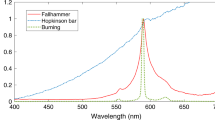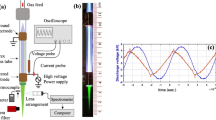Abstract
IN 1924, L. Vegard1 directed attention to the occurrence of phosphorescent bands in the region of the auroral line at 5577·35 A. when a solidified mixture of nitrogen and argon or neon is exposed to cathode-ray excitation. In a recent communication, Vegard and Kvifte2 report an observation of J. Nordhagen that pure argon at atmospheric pressure shows a green luminescence when excited by a Tesla transformer. Vegard and Kvifte suggest that the green band is a phosphorescent phenomenon initiated by the oxygen auroral line at 5577·35 A. They point out that increase in oxygen concentration above a certain value (not stated) suppresses the green phosphorescence.
This is a preview of subscription content, access via your institution
Access options
Subscribe to this journal
Receive 51 print issues and online access
$199.00 per year
only $3.90 per issue
Buy this article
- Purchase on Springer Link
- Instant access to full article PDF
Prices may be subject to local taxes which are calculated during checkout
Similar content being viewed by others
References
Vegard, L., Kon. Akad. Wet. Amsterdam, 27 (1924).
Vegard, L., and Kvifte, G., Nature, 162. 967 (1948).
Author information
Authors and Affiliations
Rights and permissions
About this article
Cite this article
JENKINS, H., BOWTELL, J. & STRONG, R. Afterglow Phenomena in Argon–Nitrogen Mixtures at Pressures Close to Atmospheric. Nature 163, 401–402 (1949). https://doi.org/10.1038/163401a0
Issue Date:
DOI: https://doi.org/10.1038/163401a0
This article is cited by
Comments
By submitting a comment you agree to abide by our Terms and Community Guidelines. If you find something abusive or that does not comply with our terms or guidelines please flag it as inappropriate.



